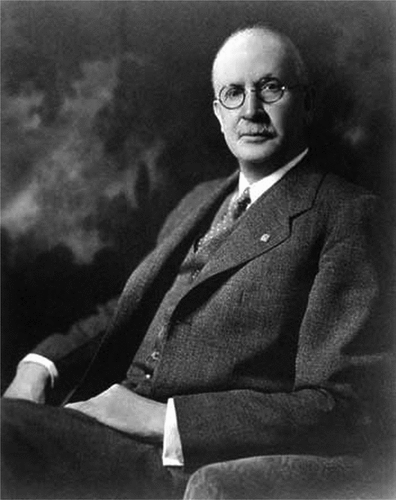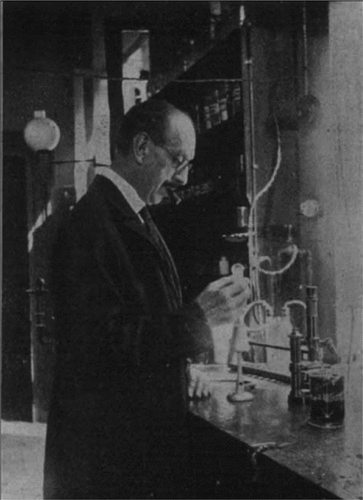Abstract
Traditionally, early liquid crystal research activities were associated with European universities, with US scientists rapidly entering the field since the 1950s. Surprisingly, some chemical research reproducing the synthesis of paraazoxyanisole as a part of the undergraduate thesis was carried out in the US as early as 1902.
Keywords:
On the second day of January, 1903 Edward Bartow, an assistant chemistry professor at the University of Kansas, delivered a paper at the Thirty-Fifth Annual Meeting of Kansas Academy of Science [Citation1]. The paper titled ‘Crystalline liquids’ was a part of a thesis presented by his student, Fred Baker Porter, to the faculty of the School of Engineering of the University of Kansas for the degree of a Bachelor of Science in chemical engineering [Citation2]. The paper reported the synthesis of paraazoxyanisole, a substance with the properties of both anisotropic crystals and isotropic liquids ().
Figure 1. Porter’s paper reporting the synthesis of paraazoxyanisole (top) and its chemical formula (bottom).

Ludwig Gattermann and his student A. Ritschke reported the synthesis of three azoxyphenolethers (paraazoxyanisole, paraazoxyphenetole, and anisolazoxyphenetole) that exhibit liquid crystal properties back in 1890 [Citation3,Citation4]. E. Bartow, who received his Ph.D. in organic chemistry under Otto Wallach, the recipient of the 1910 Nobel Prize in Chemistry for his work on alicyclic compounds, in Gottingen in 1895 [Citation5,Citation6], was aware of this important paper. Edward Bartow charged his undergraduate student, Fred B. Porter with the synthesis of the new and mysterious ‘crystalline liquid’. The synthesis of paraazoxyanisole became a topic of Porter’s undergraduate thesis. Once the project was complete, neither E. Bartow nor F. B. Porter returned to liquid crystal research. According to the Bulletin of the University of Kansas, F. B. Porter received his undergraduate degree in engineering in 1902 [Citation7]. He continued his education eventually receiving a Master of Science degree (Chemistry) in 1906 [Citation7]. Upon graduating F. B. Porter began working in the capacity of a consulting chemist and as of 1928 was listed as a chief engineer at Southwestern Laboratories residing in Fort Worth, Texas [Citation7]. E. Bartow () made an impressive career in the field of sanitary chemistry where he is best known for his work in drinking water purification and wastewater treatment [Citation5,Citation6]. Allegedly, the first synthesis of a liquid crystalline material on U.S. soil by an undergraduate chemistry student was lost in the annals of history. It took nearly six decades for liquid crystal research to reappear in the US [Citation8].
Porter’s paper, presented by Bartow at the Thirty-Fifth Annual Meeting of the Kansas Academy of Science, is just 3 pages long [Citation2]. A brief introduction describes an exotic state of matter called ‘crystalline liquids’ and refers to works by Reinitzer, Lehmann, and Gatterman. The paper provides information about two melting points of three azoxyphenolethers synthesised, followed by a step-by-step description of the chemical synthesis of paraazoxyanisole. As expected, the synthesised material exhibited two melting points. Interestingly, Porter highlights the importance of a microscope with a heating stage to study birefringence. Unfortunately, the lack of such a microscope at the University of Kansas did not allow Porter to observe the double refraction of the synthesised paraazoxyanisole [Citation2].
A few important points should be mentioned. The classical paper by Gattermann and Ritschke [Citation3] played an instrumental role during the early stages of liquid crystal research [Citation8]. It provided scientists with a step-by-step guide on the production of liquid crystal materials thus enabling experimental research in this field. For example, these liquid crystalline materials were utilised in classical experiments performed by Ch. Mauguin, F. Grandjean, V. Freedericksz and V. Zolina, M. Miesowicz, and R. Williams, to name a few [Citation4,Citation8]. Gattermann () was a renowned organic chemist [Citation4].
Bartow who also specialised in organic chemistry, did research in Germany during his graduate work (Gottingen, 1893–1895) and in the summer of 1901 when he studied under Emil Fischer in Berlin [Citation6]. Given that Bartow spent time in Germany, it is reasonable to infer that he was exposed to early research papers on liquid crystals. At that time liquid crystals were considered an academic curiosity with heated debates about their actual existence [Citation4,Citation8]. Apparently, Bartow became interested in liquid crystal materials only as a suitable research project for his student, F. Porter, who successfully completed it [Citation2]. Allegedly, this undergraduate project represents a pioneering example of educational applications involving liquid crystals within the United States.
Acknowledgments
The author is grateful to Dr. Ingo Dierking for his useful advice and encouragement.
Disclosure statement
No potential conflict of interest was reported by the author(s).
Additional information
Funding
References
- Grimsley GP. Minutes: thirty-fifth annual meeting. Kansas Acad Sci. 1903;18:14–21. JSTOR. [cited 2024 Mar 24]. http://www.jstor.org/stable/3624762
- Porter FB. Crystalline liquids. Trans Kansas Acad Sci (1903-). 1903;18:54–56. JSTOR. [cited 2024 Mar 24]. doi: 10.2307/3624766
- Gattermann L, Ritschke A. Ueber Azoxyphenoläther. Ber Dtsch Chem Ges. 1890;23(1):1738–1750. doi: 10.1002/cber.189002301285
- Sluckin TJ, Dunmur DA, Stegemeyer H. Crystals that flow: classic Papers from the history of liquid crystals. London, Great Britain: Taylor & Francis; 2004.
- Flentje ME. A tribute to Edward Bartow. J (Am Water Works Assn). 1963;55(9):1220–1224. JSTOR. [cited 2024 Mar 24]. Available from: http://www.jstor.org/stable/41257598
- Kirkpatrick SD. Edward Bartow, 1870-1958. J Am Chem Soc. 1959;81(22):5841. doi: 10.1021/ja01531a001
- Alumni Directory 1873 – 1928. Bulletin of the University of Kansas. Vol. 29. Lawrence (KS): University of Kansas; 1928.
- Dunmur D, Sluckin T. Soap, science, and flat-screen TVs. Oxford: Oxford University Press; 2011.


